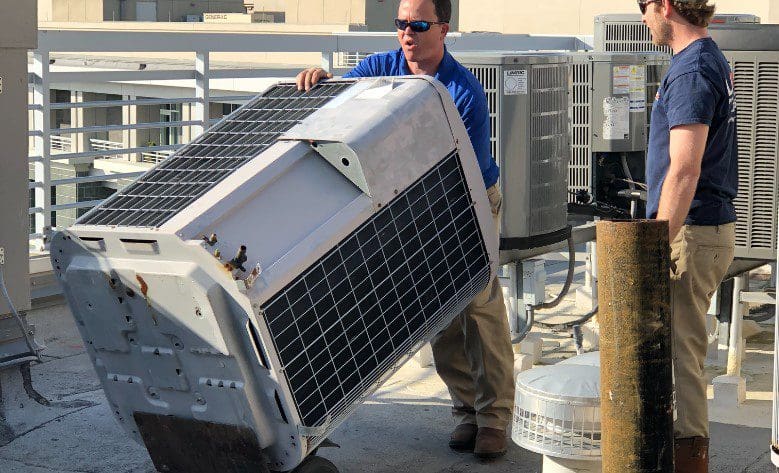How to Size a Heating and Air Conditioning System Correctly

When you’re buying an HVAC system, picking the right size for your home is key. If it’s too small, your system will struggle to keep you comfortable. If it’s too big, you’ll waste energy and end up paying more than you need to.
Whether you’re replacing an old unit or installing a new one, knowing how to size your heating and air conditioning system properly can help you save on utility bills and avoid common headaches later on.
In this guide, we’ll walk you through the key factors to consider, explain important calculations, and share tips to help you find the perfect system size for your home—so you can enjoy enhanced, energy-efficient cooling.
Why Proper HVAC Sizing is Critical for Comfort and Efficiency
Knowing how to size your heating and air conditioning system is essential for long-term comfort and performance. When your HVAC system is properly sized, it maintains a steady indoor temperature, runs efficiently, and doesn’t have to work overtime to keep up with demand.
This means lower energy bills, fewer repairs, and a longer lifespan for your system.
Improper Sizing Affects Performance
If your system is too small, it’ll run all the time but still won’t keep your home comfortable. Too big, and it cools or heats your space too fast, turning on and off constantly. This short cycling wastes energy, causes uneven temperatures, and wears out your equipment faster.
That’s why proper sizing is so important. It ensures your system runs the way it’s supposed to, efficiently, consistently, and comfortably. And in the long run, it saves you money on both your energy bill and system maintenance.
How to Determine the Size of a Heating and Air Conditioning System
When figuring out how to size a heating and air conditioning system, there’s more to consider than just the size of your home. Things like home insulation quality, window types, ductwork, ceiling height, and your local climate all affect how much heating and cooling power you need.
To get it right, you’ll want to look at the full picture so your system runs efficiently and keeps your home comfortable year-round.
Here are some tips on how to determine the right size of heating and air conditioning system for your home.
Start With Your Home’s Square Footage
The first step to knowing what size air conditioner you need is your home’s total square footage. This gives a rough idea of the heating and cooling capacity you’ll need. Generally, larger homes require more powerful systems.
However, square footage alone isn’t enough. Insulation quality, window types, and your local climate also affect your HVAC needs.
Calculate the Required Tonnage
Tonnage refers to the cooling power of an HVAC system. One ton equals 12,000 BTUs (British Thermal Units), a measure of how much heat the system can remove from your home each hour. To estimate the size of the system you need, divide your total BTU requirement by 12,000.
For example, if your home needs 24,000 BTUs, you’d likely need a 2-ton system. Keep in mind, this is just a rough estimate. Other factors, such as insulation, windows, and climate, can also affect the final size.
BTU Sizing Chart by Square Footage
One easy way to get a rough estimate is by using your home’s square footage. The AC sizing chart below gives a general guideline of how many BTUs you need based on the size of your home, from small spaces to average-sized houses.
| House Square Footage | BTUs Needed |
|---|---|
| 100 – 150 | 5,000 |
| 150 – 250 | 6,000 |
| 250 – 300 | 7,000 |
| 300 – 350 | 8,000 |
| 350 – 400 | 9,000 |
| 400 – 450 | 10,000 |
| 450 – 500 | 12,000 |
| 500 – 700 | 14,000 |
| 700 – 1,000 | 18,000 |
| 1,000 – 1,200 | 21,000 |
| 1,200 – 1,400 | 23,000 |
| 1,400 – 1,500 | 24,000 |
| 1,500 – 2,000 | 30,000 |
| 2,000 – 2,500 | 34,000 |
Get a Professional Manual J Load Calculation
The best way to size your heating and air conditioning system is to have a certified HVAC professional perform a Manual J load calculation. This method examines key details, such as your home’s insulation, windows, and air leaks, to determine precisely how much heating and cooling your house requires.
A Manual J calculation helps make sure your system isn’t too big or too small. This means it will keep your home comfortable, run more efficiently, and last longer without breaking down.
Getting this professional assessment is a smart step to avoid energy waste and save money on repairs and bills over time. To schedule a professional calculation, you can contact a LimRic pro.
Account for Load Calculation Factors
Besides just square footage, several other important factors influence the right size for your HVAC system:
- Insulation Quality: Homes with sound insulation retain heat or cool air more effectively, so they typically require less heating and cooling power. Poor insulation means your system has to work harder to maintain comfortable temperatures.
- Window Size and Type: Larger windows or older single-pane windows let in more heat during the summer and lose more warmth in the winter. This can increase the demand on your HVAC system.
- Duct Work: Well-sealed and properly sized air ducts make sure that heated or cooled air reaches every room efficiently. Leaky or poorly sized ducts cause your system to work harder and waste energy.
- Climate: Where you live matters. Homes in hot, humid climates generally require larger cooling systems, while those in colder areas need more heating capacity.
- Home Orientation: The way your house faces can impact how much sunlight it gets, affecting heating and cooling needs. For example, south-facing homes might heat up more in summer, requiring extra cooling power.
All of these factors combine to affect your home’s heating and cooling needs. Taking them into account ensures your HVAC system is sized to fit your home’s unique layout, energy efficiency, and daily usage.
Sample Load Calculation for a 2,000 Sq. Ft. Home
To help understand what a load calculation looks like in practice, take this example: a 2,000 square foot home in a moderate climate might require somewhere between 24,000 and 30,000 BTUs—that’s about 2 to 2.5 tons of cooling power.
Of course, that number can shift depending on key factors like insulation, window quality, ductwork, and how the home is laid out. That’s why a professional Manual J load calculation is the best way to get a truly accurate system size for your home.

Ready to Size Your System? Consult an HVAC Pro Today
Knowing how to size a heating and air conditioning system involves many important details that directly affect your home’s comfort and energy efficiency. While rough estimates can be helpful, the most accurate way to ensure your system is properly sized is to consult a certified HVAC professional.
At LimRic, our experienced technicians provide expert AC services tailored to your home’s unique needs. We help you avoid costly mistakes like oversizing or undersizing, ensuring your system runs efficiently and keeps you comfortable year-round.
From sizing to installation and maintenance, we’re here to guide you every step of the way for better comfort, improved efficiency, and long-term savings.If you’re ready to get the right system for your home, Contact LimRic Today.
- About Us (11)
- AC (13)
- Air Quality (10)
- Circuit Breakers (2)
- Commercial (0)
- Company News (5)
- Electrical (3)
- Electrical Repair (1)
- Energy-Efficient (4)
- Featured (0)
- Furnace (3)
- Generator Repair (1)
- Generators (1)
- Give Back Grant (3)
- Heat Pumps (1)
- Heating (6)
- HVAC (28)
- Plumbing (27)
- Residential (10)
- Thermostat (3)
- Uncategorized (54)
- Water Heater (4)
- Winter (5)











